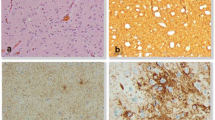Abstract
Gangliogliomas are frequent tumors in patients suffering from chronic focal epilepsies. In a series of 326 gangliogliomas, epidemiological as well as histopathological findings of gangliogliomas were reviewed. The majority of tumors arise from the temporal lobe. The combination of dysplastic neurons and neoplastic glial cell elements represent the histopathological hallmark. However, immunohistochemical studies are an additional tool to discriminate these neoplasms from other tumor entities. Eighty percent of gangliogliomas reveal immunoreactivity for CD34, a stem cell epitope not expressed in normal brain. Immunohistochemical reactions for MAP2 or NeuN can further be employed to characterize the dysplastic nature of neurons in those areas difficult to discriminate from preexisting brain parenchyma. The distinction from diffusely infiltrating gliomas is of considerable importance since tumor recurrence or malignant progression are rare events in gangliogliomas. Only little is known about the molecular pathogenesis of these glioneuronal tumors. However, our findings support a dysontogenic origin from a glioneuronal precursor lesion. Candidate genes appear to be associated with neurodevelopmental signaling cascades. Powerful new molecular genetic and biological tools can now be employed to unravel the pathogenesis of these intriguing lesions.
Zusammenfassung
Gangliogliome stellen den häufigsten Tumor bei jungen Patienten mit chronisch-fokalen Epilepsien dar. In einer Serie von 326 Gangliogliomen, die aus zahlreichen Epilepsie-chirurgischen Zentren und Instituten für Neuropathologie in Deutschland, Österreich und der Schweiz zusammengetragen wurden, haben wir sowohl klinisch-epidemiologische Eckdaten als auch histopathologische und immunhistochemische Merkmale von Gangliogliomen systematisch zusammengestellt. Die bei weitem häufigste Lokalisation stellt der Temporallappen dar. Histologisch ist der Tumor durch einen biphasischen Aufbau charakterisiert. Die Kombination einer dysplastischen Nervenzellpopulation und einer neoplastischen Gliazellpopulation gilt als charakteristisch. Dennoch unterliegt der zelluläre Aufbau von Gangliogliomen erheblichen Variationen, sodass die Abgrenzung von glialen Neoplasien eine besondere Herausforderung für die klinisch-diagnostische Neuropathologie ist. Immunhistochemische Untersuchungen sind ein wichtiges Hilfsmittel, da 80% der Gangliogliome das Stammzellepitop CD34 exprimieren. Dieses Epitop ist in normalen Zellen des Gehirns nicht nachweisbar und könnte auf eine Reifungsstörung als frühestes pathogenetisches Moment der Tumorentstehung hinweisen. Weiterhin helfen immunhistochemische Färbungen (z.B. MAP2 oder NeuN) den dysplastischen Phänotyp der Nervenzellpopulation zu belegen. Tumorrezidive oder eine maligne Progression stellen eine Ausnahme der Erkrankung dar. Hinsichtlich der molekularen Pathogenese sind unsere Erkenntnisse derzeit noch sehr unvollständig. Wir konnten jedoch erste Hinweise dafür finden, dass neurobiologisch gesteuerte Entwicklungsgene an der Entstehung von Gangliogliomen beteiligt sind. Durch die Verfügbarkeit von nativem epilepsiechirurgischem Tumorgewebe lassen sich nun mit Hilfe modernster molekularbiologischer und -genetischer Methoden die Mechanismen der Tumorentstehung gezielt weiter untersuchen.
Similar content being viewed by others
Author information
Authors and Affiliations
Additional information
Eingegangen: 15. August 2002/Akzeptiert: 14. Oktober 2002
Correspondence to:I. Blümcke
Rights and permissions
About this article
Cite this article
Blümcke, I., Müller, S. Gangliogliome: Epidemiologie und Vorschläge zu neuen Richtlinien in der klinisch-neuropathologischen Diagnostik dieses ungewöhnlichen und mit fokalen Epilepsien-assoziierten Tumors. Z Epileptol 16, 0002–0006 (2003). https://doi.org/10.1007/s10309-003-0003-y
Issue Date:
DOI: https://doi.org/10.1007/s10309-003-0003-y




